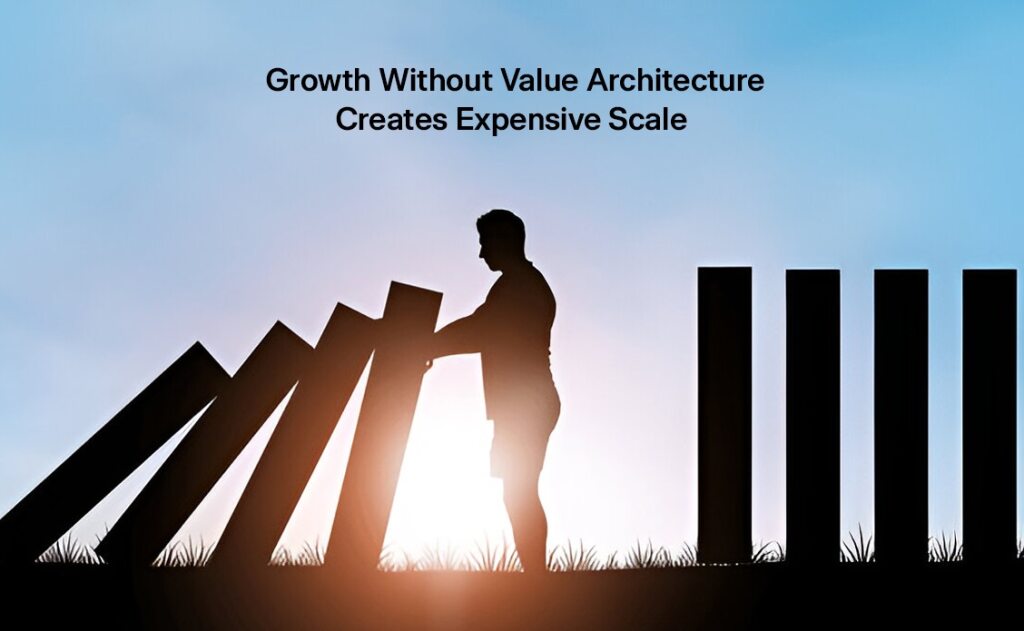The $100M Problem:
Last month, I watched a founder celebrate hitting $50M ARR—then get crushed when three separate acquirers passed after initial diligence. The feedback? “Impressive growth, but we can’t justify the multiple for a business this operationally complex.”
This wasn’t a market timing issue or competitive pressure. This was strategic malpractice. Four foundational decisions made over 18 months had systematically destroyed enterprise value while creating the illusion of successful scaling.
These aren’t execution failures—they’re foundational strategy errors that compound over time. By Series C, they become structural liabilities that sophisticated buyers can spot in the first diligence call.
Growth Without Value Architecture Creates Expensive Scale
At NextAccel, we’ve diagnosed these patterns across 80+ portfolio companies. Here are the four strategic traps that destroy enterprise value—and the frameworks to avoid them.
Mistake #1: Building for Growth Metrics Instead of Buyer Psychology
The Diagnostic Question:
“If your top 3 likely acquirers evaluated you today, which 20% of your metrics would drive 80% of their valuation? Are you investing 70%+ of your capital in that 20%?”
Most founders can’t answer this cleanly because they’re optimizing for fundraising metrics, not exit value.
The Pattern I See:
- Growth-Stage Trap: Chasing vanity KPIs like total users, pipeline volume, or market expansion that impress investors but confuse buyers
- Resource Misallocation: 60%+ of growth spend goes to initiatives that don’t align with acquirer priorities
- Strategy Drift: Teams celebrate hitting quarterly targets while unknowingly building features, customers, or operations that buyers will discount heavily
The NextAccel Value-Alignment Framework:
DEFINE Phase – Strategic Buyer Mapping:
- Identify your 3 most likely exit scenarios (Strategic, IPO, PE)
- Reverse-engineer what each buyer type values in your market
- Audit your last 12 months of strategic decisions against buyer criteria
- Quantify the gap between your current metrics and exit-relevant KPIs
The Fix: Embed exit-thesis thinking into every strategic decision. Before approving any growth initiative, ask: “Would our likely acquirer see this as a strategic asset or expensive distraction?”
Mistake #2: Scaling Operations for Efficiency Instead of Acquisition Readiness
The Reality Check:
“Show me your operational infrastructure and I’ll predict your diligence timeline. Companies with acquirer-ready operations close exits in 6-9 months. Companies with founder-dependent systems take 18+ months—if they close at all.”
The Operational Debt I Diagnose:
- Financial Architecture: Revenue recognition practices that don’t meet buyer accounting standards
- Technology Infrastructure: Custom systems and integrations that create diligence complexity
- Team Dependencies: Critical knowledge concentrated in founders or key employees without documentation
- Governance Gaps: Board reporting, compliance frameworks, and decision-making processes that sophisticated buyers expect
The NextAccel DEPLOY Framework for Acquisition-Ready Operations:
Financial Readiness Audit:
- GAAP-compliant revenue recognition (even if not required today)
- Monthly close processes that complete within 5 business days
- Clean revenue segmentation by product, geography, and customer type
- Defensible CAC/LTV calculations with cohort-based validation
Technology Due Diligence Preparation:
- API-first architecture that supports integrations
- Data portability and export capabilities
- Security compliance appropriate for enterprise buyers
- Documentation of all technical dependencies and single points of failure
Organizational Scalability:
- Process documentation for all critical business functions
- Management team with exit-stage experience
- Employee retention and knowledge transfer protocols
- Performance management systems that operate without founder involvement
I tell clients: “Every operational shortcut you take today becomes a valuation discount tomorrow. Buyers pay premiums for companies they can integrate seamlessly, not fix extensively.”
Mistake #3: Building Product Depth Instead of Strategic Width
The Strategic Question:
“Is your product roadmap designed to solve more customer problems, or to become more valuable to acquirers? The difference determines whether you build a feature factory or a strategic asset.”
The Product Strategy Trap:
Most founders optimize product development for user satisfaction and competitive differentiation. But buyers evaluate products through acquisition logic—integration potential, market position, and strategic fit.
The NextAccel Product-Value Matrix:
Strategic Acquirer Priorities:
- Features that integrate with their existing product suite
- Technology that fills gaps in their platform architecture
- Market presence in segments they want to enter
- IP and capabilities that create competitive moats
IPO Readiness Focus:
- Scalable product architecture that supports enterprise growth
- Feature differentiation that justifies premium pricing
- Product-led growth mechanisms that reduce customer acquisition costs
- Technology infrastructure that meets public company security standards
PE Value Creation:
- Product efficiency that improves unit economics
- Upsell and cross-sell capabilities that increase customer lifetime value
- Product standardization that reduces support costs
- Market positioning that supports pricing power
Tactical Implementation:
Before prioritizing any product initiative, score it against your primary exit scenario:
Strategic Fit (1-10): How valuable is this to likely acquirers?
Integration Complexity (1-10): How easily can buyers incorporate this?
Market Impact (1-10): Does this strengthen our position in target segments?
Mistake #4: Optimizing for Today’s Market Instead of Tomorrow’s Consolidation
The Market Positioning Reality:
“Most founders build for current competitive dynamics, not future market structure. But acquirers buy companies for where markets are heading, not where they are today.”
The Shortsighted Strategy Pattern:
- Competitive Myopia: Responding to current competitors instead of anticipating consolidation
- Market Timing Mistakes: Entering crowded segments instead of positioning for inevitable roll-ups
- Technology Betting Errors: Building for today’s infrastructure instead of next-generation platforms
The NextAccel DELIVER Framework for Future-Market Positioning:
Market Evolution Analysis:
- Map your industry’s consolidation timeline (most B2B markets consolidate within 7-10 years)
- Identify which large players will likely become acquirers vs. competitors
- Anticipate regulatory changes that will favor scale or specialization
- Position your company as either a platform play or best-in-class specialist
Strategic Positioning Choices:
Platform Strategy (High Risk, High Reward):
- Build horizontal capabilities that support multiple use cases
- Invest in ecosystem development and third-party integrations
- Target market leadership through acquisition and partnerships
- Optimize for winner-take-all scenarios
Specialist Strategy (Lower Risk, Predictable Value):
- Dominate specific niches that large players can’t serve effectively
- Build deep expertise that’s difficult for platforms to replicate
- Position as strategic acquisition target for platform consolidators
- Optimize for premium exit multiples through specialization
The Quarterly Market Reality Check:
“If the three largest players in your space merged tomorrow, would you be more valuable or less valuable? Your answer determines whether you’re building toward consolidation or despite it.”
Value Creation Is Strategy Execution
Enterprise value isn’t created by accident, it’s the result of systematic strategic decisions aligned with buyer psychology. Every tactical choice either builds toward your exit thesis or detracts from it.
The founders who achieve premium exits think like acquirers from Day One. They build companies that solve buyer problems, not just customer problems.
Open to audit your strategic value creation?
Contact us for our 90-minute Enterprise Value Diagnostic to understand strategic decisioning toward premium exit multiples and hidden valuation discounts.



